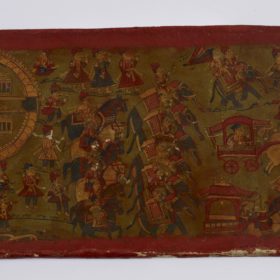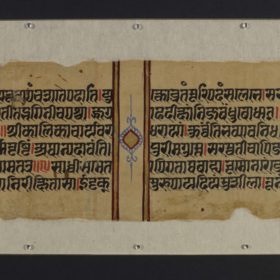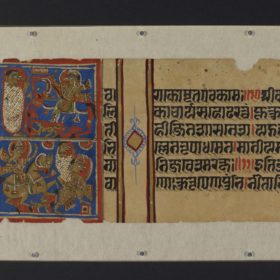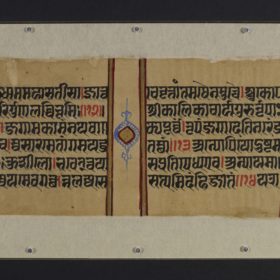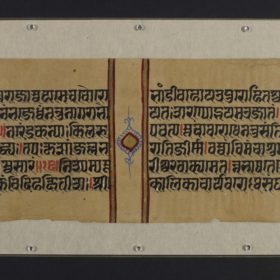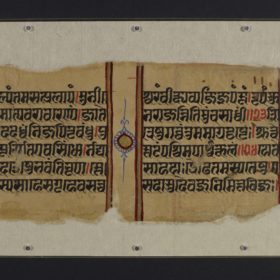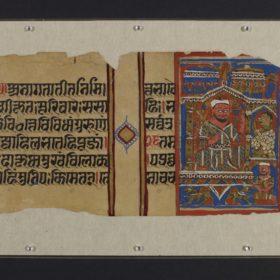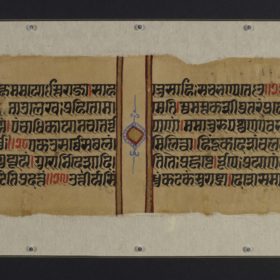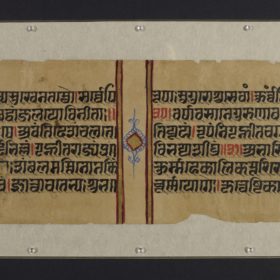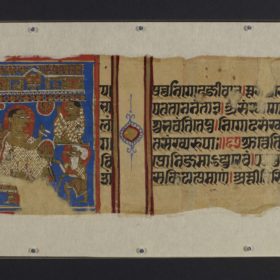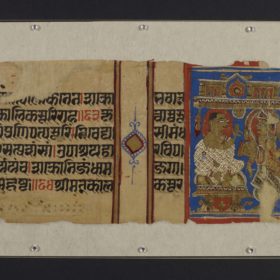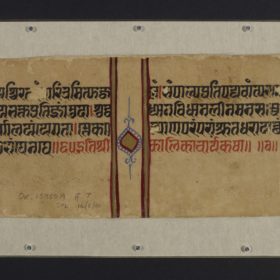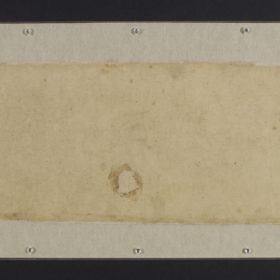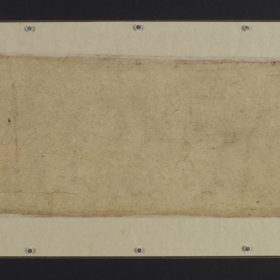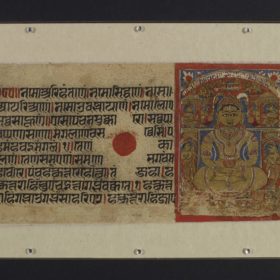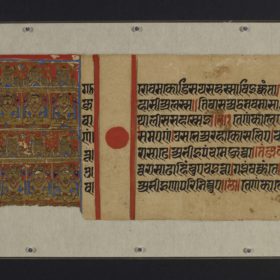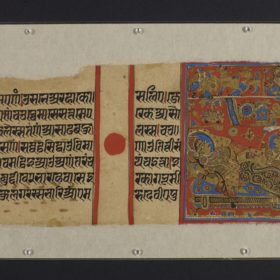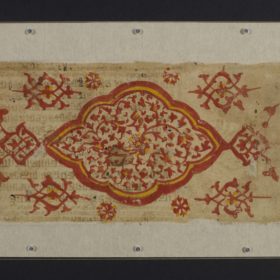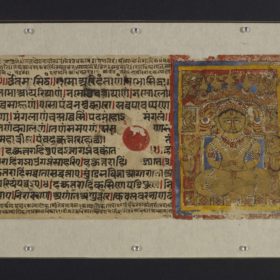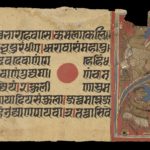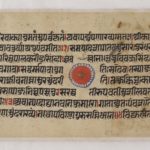
Background
The Kālakācārya-kathā – Story of the religious teacher Kālaka – emphasises the connection between religious practice and magical abilities. As an accomplished Jain teacher, Kālaka can master various magical sciences and transmute brick into gold. He uses his powers to help the Śakas, a foreign population. In exchange, the Śakas help him destroy the wicked King Gardabhilla.
This eventful tale belongs to the Śvetāmbara Jain tradition. It is known in several versions in various languages and is often illustrated.The one in this manuscript is an anonymous text in Sanskrit verse, but the first seven stanzas are missing. Also missing are folios 191 to 197, corresponding to stanzas 33 to 61.
This version is known as Śrīvīra-vākyānumatam from its starting words. It is a short recension, where the story is told in simple language without poetical embellishments. By an unknown author, it is one of the most popular versions of the Kālaka story.
Assorted folios
The pages or folios under this shelfmark belong to different manuscripts. The folios show a variety of handwriting, language and artistic style and are on noticeably different paper.
The folios are from four separate manuscripts, as follows:
- several folios are from a single manuscript of the Kālakācārya-kathā – Story of the Ācārya Kālaka
- three folios are from different manuscripts of the Kalpa-sūtra, an extremely popular text in the Śvetāmbara canon.
There is also a manuscript holder made for an unknown manuscript.
It is not known what has happened to the rest of each manuscript.
Copies of the Kalpa-sūtra and Kālakācārya-kathā are often made in a single manuscript, which may be why these folios were bundled together. At some point in the past these folios and the manuscript holder were put into a box at the British Library and labelled ‘Frags. of Jain Mss. Skt. / Pkt.’ meaning 'Fragments of Jain manuscripts in Sanskrit and Prakrit'. However, it is important to remember that they do not belong together.
Glossary
Description
This page consists of stanzas 15 to 17 of this Sanskrit version of the popular story of Kālaka.
The monk Kālaka continues to address King Gardabhilla, who has just kidnapped his sister, the nun Sarasvatī. He tries to convince the king to leave her alone, reminding him of a monarch’s duty. He says that behaviour like his is a sign that the population is not safe. Moreover, the monk says, the king must have enough beautiful ladies in his harem.
Gardhabhilla listens without replying.
Other visual elements
There are several notable things about this page, which is not in perfect condition as the edges are slightly torn.
The Kālaka story is often an appendix to Kalpa-sūtra manuscripts. In many Kalpa-sūtra manuscripts, there is a clear intention to make the manuscript a valuable and remarkable object in itself. This often holds true for the manuscripts of the Kālaka story as well. Here this aim is signalled by the:
- shape and style of the script, which is close to calligraphy
- use of gold ink for the red-edged border lines and ornamental diamond shapes
- division of the text into two equally-sized panels, separated by a 2-centimetre margin containing a golden diamond
- blue ornamental motifs around the golden diamonds.
There are three ornamental diamonds because this is the verso side of a folio.
This version of the Kālaka story is told in poetry. Verse numbers are at the end of each stanza. They are often in red, like here. On this page are the following numbers:
- 15 on line 3
- 16 on line 5
- 14 on the last line.
This means that this page contains verses 15 and 16, and part of verse 17.
The bottom of the right margin contains the number 188, which is the folio number. It is a high number because this manuscript is the continuation of a Kalpa-sūtra manuscript. However, the rest of the manuscript is not available.
Script
The elaborate script used is the Jaina Devanāgarī script, which is here like calligraphy. There are a few notable features of this script.
Firstly, it is an old type in the way the sounds e and o are notated when used with a consonant, known as pṛṣṭhamātrā script.
There are red vertical lines within the text marking out verse divisions. Single red vertical lines indicate where a verse is divided in two, while double red vertical lines are found at the end of the verse.
- Source:
The British Library Board
- Shelfmark:
Or. 13950
- Author:
unknown
- Date of creation:
unknown
- Folio number:
188 verso
- Total number of folios:
10
- Place of creation:
western India
- Language:
various in Devanāgarī script
- Medium:
opaque watercolour on paper
- Size:
25 x 10.5 cms
- Copyright:
CC0 1.0 (Creative Commons Public Domain)
- Image Copyright:
- +
- aAbhavya
- aAbhinandana
- aAbhiṣeka
- aĀcāra
- aĀcārāṅga-sūtra
- aĀcārya
- aAchalbhrata
- aAḍhāī-dvīpa
- aAdharma
- aAdho-loka
- aAdhyayana
- aAdvaita Vedānta
- aĀgama
- aAghātīya
- aAghātīya-karman
- aAgnibhuti
- aAgra
- aĀhāra
- aAhiṃsā
- aAhimsa Day
- aAjita
- aAjīva
- aAkampit
- aĀkāśa
- aAkbar the Great
- aAkṣaya-tṛtīyā
- aAlauddin Khalji
- aAlbert Einstein
- aAllah
- aAlms
- aĀlocanā
- aAloka-ākāśa
- aAmāri
- aAmbikā or Kūṣmāṇḍinī
- aAnagāra
- aAnanta
- aAnarthadaṇḍa
- aAnaśana
- aAnekānta-vāda
- aAṅga
- aAniconism
- aAnojjā
- aAntarāla
- aAntarāya-karma
- aAṇu
- aAṇu-vrata
- aAnukampā
- aAnuprekṣā
- aAnusvāra
- aApabhraṃśa
- aAparigraha
- aAra
- aĀrambha
- aĀrambhaja
- aĀratī
- aArdhamāgadhī Prākrit
- aArhaṃ
- aArhat
- aArśana-āvaraṇīya-karma
- aĀrta-dhyāna
- aĀryikā
- aĀryikā Jñānamati
- aĀśātanā
- aĀścarya
- aAscetic
- aAsceticism
- aAshram
- aAspiration
- aĀsrava
- aAṣṭa-maṅgala
- aAṣṭāpada
- aAstikāya
- aAstrolabe
- aAsura
- aAtheism
- aAticāra
- aAtiśayakṣetra
- aAtithisaṃvibhāgavrata
- aĀtma-vāda
- aĀtman
- aAuṃ
- aAurangzeb
- aAuspicious
- aAusterity
- aAvadhāna
- aAvadhi-jñāna
- aĀvaraṇī-yakarman
- aAvasarpiṇī
- aAvatāra
- aAvidyā
- aAxiom
- aĀyāga-paṭa
- aĀyambil
- aĀyu-karma
- aĀyurveda
- bBabur
- bBāhubali
- bBaladeva
- bBālāvabodha
- bBandha
- bBasadi
- bBazaar
- bBhadrankarvijay
- bBhagavant
- bBhaktāmara-stotra
- bBhakti
- bBhale
- bBharata
- bBhāṣā
- bBhāṣya
- bBhaṭṭāraka
- bBhāva
- bBhāva-pūjā
- bBhāvanā
- bBhavana-vāsin
- bBhavya
- bBhavyatva
- bBhaya
- bBhoga-bhūmi
- bBhogopabhoga
- bBodhi
- bBollywood
- bBrahmā
- bBrahma-deva
- bBrahmacārī
- bBrāhmaṇa
- bBraj Bhāṣā
- bBright fortnight
- bBritish Raj
- bBuddha
- bBuddhi-sagar
- bBuddhism
- bBuddhist
- cCaitya
- cCaityavāsin
- cCakravartin
- cCakreśvarī
- cCāmara
- cCandanā
- cCandragupta
- cCandraprabha
- cCanon
- cCāritra
- cCāritramohanīya-karman
- cCarũrī
- cCaste
- cCaturvidha-saṅgha
- cCaturviṃśati-stava
- cCāturyāma
- cCE
- cCelibacy
- cCha
- cChadmastha
- cChastity
- cCheda-sūtra
- cChristian
- cChristianity
- cClergy
- cCloning
- cColophon
- cCommentary
- cConch
- cConfession
- cCongregation
- cConsecration
- cCosmology
- cCremation
- cCrore
- cCult
- cCūrṇi
- dDādā-guru
- dDalit
- dDāna
- dDaṇḍa
- dDark fortnight
- dDarśana
- dDarśanamohanī-yakarman
- dDaśa-lakṣaṇa-parvan
- dDeity
- dDelhi Sultanate
- dDerāsar
- dDeśāvakāśika-vrata
- dDetachment
- dDevanāgarī
- dDevānandā
- dDevarddhi-gani
- dDevotee
- dDhamal
- dDhanuṣ
- dDhāra
- dDharma
- dDharma-dhyāna
- dDharma-sāgara
- dDharmastikaya
- dDhātakīkhaṇḍa
- dDholak
- dDhyāna
- dDiaspora
- dDig-vrata
- dDigambara
- dDīkṣā
- dDisciple
- dDīvālī
- dDivya-dhvani
- dDNA
- dDoctrine
- dDogma
- dDonor
- dDoṣa
- dDravya
- dDravya-pūjā
- dDrone
- dDuṣamā
- dDuṣamā-duṣamā
- dDuṣamā-suṣamā
- dDveṣa
- dDvīpa
- eEast India Company
- eEightfold Path
- eEkānta-vāda
- eEkendriya
- eElder
- eElders
- eEschatology
- eEtc up to
- fFarmān
- fFast
- fFatehpur Sikri
- fFestival
- fFestschrift
- fFiruz Shah
- fFly-Whisks
- fFolio
- fFour Noble Truths
- gGaccha
- gGaṇa
- gGaṇadhara
- gGanadharavada
- gGaṇeśa
- gGaṇin
- gGarba
- gGarbha
- gGarbha-gṛha
- gGaruḍa
- gGati
- gGene
- gGenomics
- gGhātī-yakarman
- gGhātīya
- gGhaznavid
- gGhiyasuddin Tughlaq
- gGhurid
- gGloss
- gGotra-karma
- gGujarāt
- gGujarati
- gGuṇa
- gGuṇa-sthāna
- gGuṇa-vrata
- gGupti
- gGuru
- gGuruṇī
- hHagiography
- hHajj
- hHaṃsa
- hHaribhadra
- hHariṇaigameṣin
- hHasta
- hHeresy
- hHiṃsā
- hHindi
- hHindu
- hHinduism
- hHīravijaya
- hHoroscope
- hHrīṃ
- hHumayun
- hHymn
- iIconoclasm
- iIconography
- iIdol
- iIndian Independence
- iIndology
- iIndra
- iIndrabhūti Gautama
- iIndriya
- iInitiation
- iIntercession
- iInvocation
- iIQ
- iIslam
- iIslamicate
- iIṣṭadevatā
- iĪśvara
- jJagat
- jJahangir
- jJain
- jJaina Devanāgarī
- jJaina Śaurasenī
- jJaina-dharma
- jJainaśāsana
- jJainness
- jJaisalmer
- jJamāli
- jJambū-dvīpa
- jJames Burgess
- jJanma
- jJanma-kalyāṇa
- jJarā
- jJāti
- jJina
- jJina-āgama
- jJina-bhavana
- jJina-bimba
- jJina-mātā
- jJinacandra-sūri
- jJinadatta
- jJinaprabha
- jJīva
- jJñāna
- jJñāna-āvaraṇīya-karma
- jJñāna-āvarṇiya
- jJñānsundar
- jJyotiṣka
- kKāla
- kKālakācārya-kathā
- kKālidāsa
- kKalpa-sūtra
- kKalpa-vṛkṣa
- kKalyāṇaka
- kKalyanvijay
- kKamaṇḍalu
- kKamaṭha
- kKarma
- kKarma-bhūmi
- kKarma-grantha
- kKarma-prakṛti
- kKarma-vāda
- kKarmon
- kKarnataka
- kKaṣāya
- kKathā
- kKāvya
- kKāya
- kKāyotsarga
- kKeśa-loca
- kKetu
- kKevala-jñāna
- kKevalin
- kKhalji
- kKharatara-gaccha
- kKnowledge
- kKriyā
- kKriyā-vāda
- kKṛṣṇa
- kKṣamā-śramaṇa
- kKṣapakaśreṇi
- kKṣatriya
- kKṣullaka
- kKulakara
- kKundakunda
- kKunthu
- lLabdhi
- lLaity
- lLakh
- lLāñchana
- lLands of Action
- lLaukāntika
- lLavaṇa-samudra
- lLeśyā
- lLiṅga
- lLinguistics
- lLoka
- lLoka-ākāśa
- lLoka-puruṣa
- lLoka-vāda
- lLotus
- lLotus lake
- mMadhya-loka
- mMahā-videha
- mMahā-vrata
- mMahābhārata
- mMahāmastakābhiṣeka
- mMāhārāṣṭra
- mMāhārāṣṭrī Prākrit
- mMahattarā Yākinī
- mMahāvīr Jayantī
- mMahāvīra
- mMakāra
- mMakkhali Gośāla
- mMalli
- mMāna-stambha
- mManaḥ-paryāya-jñāna
- mMaṇḍala
- mMaṇḍapa
- mMandit
- mMaṅgala
- mMantra
- mMantras
- mManuṣya-loka
- mMarāṭhī
- mMārgaṇā
- mMartyr
- mMarudevī
- mMaṭha
- mMati-jñāna
- mMauryaputra
- mMecca
- mMendicant lineage
- mMetarya
- mMiracle
- mMithyādṛṣṭi
- mMohandas Gandhi
- mMohanīya-karma
- mMokṣa
- mMonastic order
- mMonasticism
- mMonk
- mMonotheism
- mMosque
- mMount Meru
- mMount Sammeta
- mMṛgāvatī
- mMughal
- mMuhammad
- mMuhammad bin Tughlaq
- mMuhpattī
- mMūla-sūtra
- mMūlaguṇa
- mMumbaī
- mMuni
- mMunisuvrata
- mMurad Bakhsh
- mMūrti-pūjaka
- mMuslim
- mMysticism
- nNābhi
- nNāga-kal
- nNāgapurīya Tapā-gaccha
- nNāgarī
- nNāma-karma
- nNamaskāra-mantra
- nNami
- nNandīśvara-dvīpa
- nNandivardhana
- nNandyāvarta
- nNāraka
- nNāraki
- nNasalisation
- nNātha
- nNavrātrī
- nNaya-vāda
- nNemi
- nNidāna
- nniggaṃthāṇa vā 2
- nniggaṃtho vā 2
- nNigoda
- nNihnava
- nNikṣepa
- nNirgrantha
- nNirjarā
- nNirvāṇa
- nNiryukti
- nNiṣidhi
- nNitya
- nNiyati
- nNo-kaṣāya
- nNudity
- nNun
- oOcean of milk
- oOmniscience
- oOrdination
- ppa°
- pPadmaprabha
- pPadmāsana
- pPadmāvatī
- pPādukā
- pPalanquin
- pPalette
- pPañca-muṣṭi
- pPāṇḍava
- pPaṇḍit
- pPandit Dalsukh D. Malvania
- pPandit Sukhlalji
- pPāṇipātra
- pPāpa
- pParamātman
- pParameṣṭhin
- pPāraṇā
- pParigraha
- pPariṇāma
- pParīṣaha
- pParokṣa
- pPārśva
- pPārśvanātha
- pParyāya
- pParyuṣaṇ
- pPaṭa
- pPatan
- pPātra
- pPenance
- pPersian
- pPhala
- pPhilology
- pPicchikā
- pPilgrimage
- pPīr
- pPolymath
- pPoṣadha
- pPossession
- pPothī
- pPrabhas
- pPradakṣiṇā
- pPradeśa
- pPrākāra
- pPrakīrṇaka-sūtra
- pPrākrit
- pPramāda
- pPramukhā
- pPrati-vāsudeva
- pPratikramaṇa
- pPratimā
- pPratiṣṭhā
- pPratyākhyāna
- pPratyakṣa
- pPravacana
- pPrāyaścitta
- pPrayer
- pPre-modern
- pPreach
- pPredestination
- pProtestant
- pProvenance
- pPudgala
- pPūjā
- pPujārī
- pPukharavara-dvīpa
- pPuṇya
- pPūrva
- pPuṣkara-dvīpa
- pPuṣpadanta
- pPyre
- qQur’an
- rRāga
- rRāhu
- rRainy season
- rRajasthan
- rRajasthani
- rRājimatī
- rRajoharaṇa
- rRajput
- rRāma
- rRāmāyaṇa
- rRangoli
- rRās-garbā
- rRasa
- rRathanemi
- rRatna-traya
- rRātri-bhojana
- rRaudra-dhyāna
- rRecto
- rRelic
- rRenunciation
- rRetroflex
- rRevatī
- %Ṛg-veda
- rRite
- rRosary
- %Ṛṣabha
- %Ṛṣabhanātha
- rRupee
- sSaciyā Mātā
- sSādhu
- sSādhvī
- sSāgāra
- sSaint
- sŚaivaism
- sŚaka-saṃvat
- sSallekhanā
- sŚalya
- sSamacatuṣṭha
- sSamādhimaraṇa
- sSamaṇi
- sSāmarambha
- sSamavasaraṇa
- sSāmāyika
- sSaṃbhava
- sSamiti
- sSaṃjñā
- sSaṃkalpaja
- sSaṃsāra
- sSamudghāta
- sSaṃvara
- sSaṃvega
- sSamyak-cāritra
- sSamyak-darśana
- sSamyak-jñāna
- sSamyaktva
- sSaṃyama
- sSanctuary
- sSandalwood
- sSaṇgha
- sSanskrit
- sSant
- sŚānti
- sSapta-bhaṅgi-naya
- sSārambha
- sSarasvatī
- sSarvajña
- sSāsan-devi
- sŚāsana-devatā
- sŚāstra
- %Ṣaṭ-jīvanikāya
- sSatī
- sSatīmātā
- sSatya
- sSchism
- sScribe
- sScripture
- sSect
- sSecularism
- sŚenāī
- sSermon
- sŚeṣavatī
- sSevā
- sSeven fields of donation
- sShah Jahan
- sShantidas Jhaveri
- sShrine
- sSiddha
- sSiddha-śilā
- sSiddhacakra or Navadevatā
- sSiddhānta
- sSiddhārtha
- sSiddhi
- sSikh
- sSikhism
- sŚikṣā-vrata
- sŚīla
- sSin
- sSindh
- sŚītala
- sŚiva
- sSkandha
- sSomanatha
- sŚraddhā
- sŚramaṇa
- sŚrāvaka
- sŚrāvakācāra
- sŚrāvikā
- sŚreyāṃsa
- sŚrī
- sŚrīvatsa
- sŚruta-jñāna
- sŚruta-pañcamī
- sSthānaka-vāsin
- sSthāpanācārya
- sSthāvara
- sSthavira
- sSthiti
- sStrīmukti
- sStūpa
- sSubcontinent
- sSudarshana
- sŚuddhi
- sSudharma
- sŚūdra
- sSufism
- sSukha
- sŚukla-dhyāna
- sSulasā
- sSultan
- sSumati
- sSundarśrī
- sSupārśva
- sSūri
- sSuṣamā
- sSuṣamā-duṣamā
- sSuṣamā-suṣamā
- sSūtra
- sSuyam me ausam! Tenam bhagavaya evamakkhayam
- sSvādhyāya
- sSvāhā
- sSvastika
- sŚvetāmbara
- sŚvetāmbara Terāpanthin
- sŚvetāmbaras
- sSwan
- sSyād-vāda
- tTabla
- tTantra
- tTapā-gaccha
- tTapas
- tTāraṇ Svāmī Panth
- tTattva
- tTattvārtha-sūtra
- tTemple
- tTemple-city
- tThe Enlightenment
- tTheology
- tThree worlds
- %Ṭīkā
- tTilaka
- tTīrtha
- tTīrthaṃkaranāma-karman
- tTīrthankara
- tTransliteration
- tTrasa
- tTrasa-nāḍī
- tTriśalā
- tTriṣaṣṭi-śalākā-puruṣa-caritra
- tTti bemi
- tTughlaq
- tTunk
- uUdumbara
- uUniversal History
- uUpādhyāya
- uUpāṅga
- uUpaniṣads
- uUpāsaka
- uUpasarga
- uUpāśraya
- uŪrdhva-loka
- uUtsarpiṇī
- uUttarādhyayana-sūtra
- vVāhana
- vVaimānika
- vVairāgya
- vVaiṣṇava
- vVaiśramaṇa
- vVaiśya
- vValabhī
- vVanaspatikāya
- vVandana
- vVaṇik
- vVarṇa
- vVāsudeva
- vVāsupūjya
- vVayubhūti
- vVeda
- vVedanīya-karma
- vVegetarianism
- vVehicle
- vVernacular
- vVerso
- vVidyā
- vVidyā-devī
- vVihāra
- vVijñapti-patra
- vVikrama-saṃvat
- vVikṛti
- vVimala
- vVinaya
- vVipāka
- vVirji Vora
- vVirodhaja
- vVīrya
- vVisarga
- vViṣṇu
- vVītarāga
- vVizier
- vVotive
- vVow
- vVrata
- vVS
- vVyakta
- vVyantara
- vVyasana
- yYakṣa
- yYakṣī
- yYantra
- yYaśoda
- yYaśovijaya
- yYati
- yYātrā
- yYoga
- yYoginī
- yYojana
Description
This page consists of stanzas 15 to 17 of this Sanskrit version of the popular story of Kālaka.
The monk Kālaka continues to address King Gardabhilla, who has just kidnapped his sister, the nun Sarasvatī. He tries to convince the king to leave her alone, reminding him of a monarch’s duty. He says that behaviour like his is a sign that the population is not safe. Moreover, the monk says, the king must have enough beautiful ladies in his harem.
Gardhabhilla listens without replying.
Other visual elements
There are several notable things about this page, which is not in perfect condition as the edges are slightly torn.
The Kālaka story is often an appendix to Kalpa-sūtra manuscripts. In many Kalpa-sūtra manuscripts, there is a clear intention to make the manuscript a valuable and remarkable object in itself. This often holds true for the manuscripts of the Kālaka story as well. Here this aim is signalled by the:
- shape and style of the script, which is close to calligraphy
- use of gold ink for the red-edged border lines and ornamental diamond shapes
- division of the text into two equally-sized panels, separated by a 2-centimetre margin containing a golden diamond
- blue ornamental motifs around the golden diamonds.
There are three ornamental diamonds because this is the verso side of a folio.
This version of the Kālaka story is told in poetry. Verse numbers are at the end of each stanza. They are often in red, like here. On this page are the following numbers:
- 15 on line 3
- 16 on line 5
- 14 on the last line.
This means that this page contains verses 15 and 16, and part of verse 17.
The bottom of the right margin contains the number 188, which is the folio number. It is a high number because this manuscript is the continuation of a Kalpa-sūtra manuscript. However, the rest of the manuscript is not available.
Script
The elaborate script used is the Jaina Devanāgarī script, which is here like calligraphy. There are a few notable features of this script.
Firstly, it is an old type in the way the sounds e and o are notated when used with a consonant, known as pṛṣṭhamātrā script.
There are red vertical lines within the text marking out verse divisions. Single red vertical lines indicate where a verse is divided in two, while double red vertical lines are found at the end of the verse.





























































































